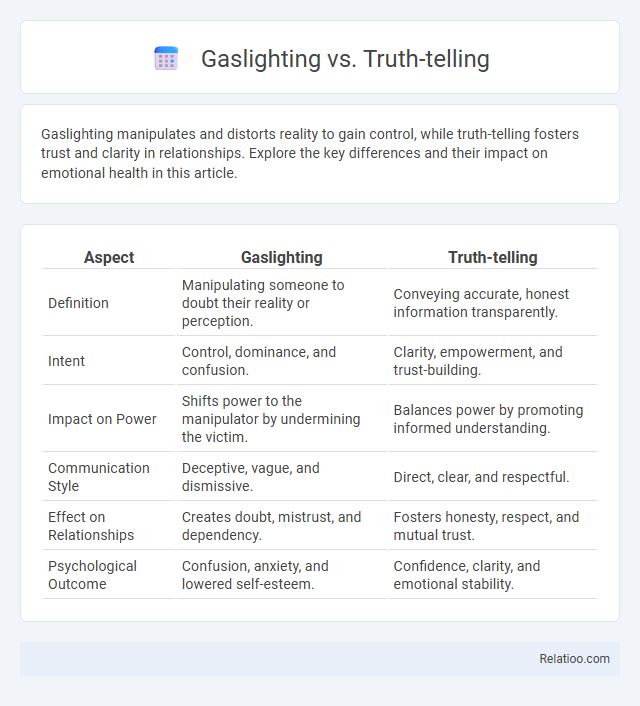Gaslighting manipulates and distorts reality to gain control, while truth-telling fosters trust and clarity in relationships. Explore the key differences and their impact on emotional health in this article.
Table of Comparison
| Aspect | Gaslighting | Truth-telling |
|---|---|---|
| Definition | Manipulating someone to doubt their reality or perception. | Conveying accurate, honest information transparently. |
| Intent | Control, dominance, and confusion. | Clarity, empowerment, and trust-building. |
| Impact on Power | Shifts power to the manipulator by undermining the victim. | Balances power by promoting informed understanding. |
| Communication Style | Deceptive, vague, and dismissive. | Direct, clear, and respectful. |
| Effect on Relationships | Creates doubt, mistrust, and dependency. | Fosters honesty, respect, and mutual trust. |
| Psychological Outcome | Confusion, anxiety, and lowered self-esteem. | Confidence, clarity, and emotional stability. |
Understanding Gaslighting: Definition and Origins
Gaslighting is a manipulative tactic where false information is presented to make someone doubt their memory or perception, originating from the 1938 play "Gas Light." Understanding gaslighting is crucial for recognizing emotional abuse and protecting your mental health. This form of psychological manipulation often blurs the line between truth-telling and victimization, making it essential to distinguish facts from distorted narratives.
Truth-telling: The Foundation of Authentic Communication
Truth-telling is essential for authentic communication, anchoring relationships in trust and transparency by presenting facts without distortion or manipulation. It counters gaslighting, which undermines perception and reality, fostering clarity and mutual understanding. Embracing truth-telling empowers individuals to avoid victimization by asserting their genuine experiences and promoting emotional resilience.
Key Differences Between Gaslighting and Truth-telling
Gaslighting involves manipulating someone into doubting their reality, often through denial, misinformation, and psychological manipulation. Truth-telling, by contrast, prioritizes honesty, clarity, and transparency, providing factual information without intent to confuse or undermine the listener's perception. The key difference lies in the intent and outcome--gaslighting distorts truth to control or harm, while truth-telling aims to inform and empower.
Psychological Impact of Gaslighting vs Truth-telling
Gaslighting undermines an individual's perception of reality, leading to confusion, anxiety, and diminished self-esteem, while truth-telling strengthens cognitive clarity and emotional resilience by affirming objective reality. The psychological impact of gaslighting often includes chronic self-doubt and trauma, contrasting sharply with truth-telling, which fosters empowerment and mental stability. Victimization exacerbates these effects by reinforcing feelings of helplessness, making the distinction between gaslighting and truth-telling critical in therapeutic and interpersonal contexts.
Common Signs of Gaslighting in Relationships
Gaslighting in relationships often involves persistent denial of facts, manipulation of reality, and dismissal of the partner's feelings, leading to confusion and self-doubt. Common signs include frequent lying, contradiction of previously stated events, and making the victim feel overly sensitive or irrational for expressing concerns. Recognizing these behaviors is crucial to distinguish gaslighting from honest truth-telling or genuine victimization.
The Role of Truth-telling in Healthy Boundaries
Truth-telling plays a crucial role in establishing healthy boundaries by promoting clear communication and self-respect, which prevents gaslighting and victimization. When you consistently express your reality and feelings honestly, it reinforces your autonomy and helps others understand your limits, reducing manipulation risks. Maintaining this transparency fosters mutual trust and empowers you to identify and address toxic behaviors effectively.
Why Gaslighting Persists: Motivations and Consequences
Gaslighting persists due to the gaslighter's motivation to gain control, manipulate perceptions, and avoid accountability by distorting the victim's sense of reality. This psychological abuse undermines trust, leading victims to question their own memories and judgments, which reinforces the gaslighter's dominance. Consequences include long-term emotional trauma, impaired decision-making, and difficulty distinguishing truth from manipulation, perpetuating a cycle of victimization.
Strategies for Confronting Gaslighting with Truth
Confronting gaslighting with truth requires clear documentation of facts, consistent communication, and maintaining firm boundaries to protect Your reality. Utilize objective evidence, such as recorded conversations or written notes, to counteract distortion and challenge false narratives effectively. Empowering Yourself through assertive truth-telling disrupts gaslighting patterns and reduces victimization by reclaiming control over Your perceptions.
Healing from Gaslighting: Reclaiming Your Reality
Healing from gaslighting involves recognizing distorted narratives and reaffirming your perception of reality through trusted sources and self-validation. Truth-telling plays a crucial role by exposing manipulative tactics, allowing survivors to dismantle false beliefs imposed by their abusers. Effective recovery requires overcoming victimization mindset, empowering individuals to regain control, rebuild self-esteem, and establish healthy boundaries.
Building a Culture of Honesty: The Power of Truth-telling
Building a culture of honesty requires understanding the distinctions between gaslighting, truth-telling, and victimization, where truth-telling fosters transparency and trust. You can cultivate an environment that values authentic communication by consistently validating facts and encouraging accountability. Emphasizing truth over manipulation or undue victimhood strengthens relationships, promoting resilience and mutual respect.

Infographic: Gaslighting vs Truth-telling
 relatioo.com
relatioo.com